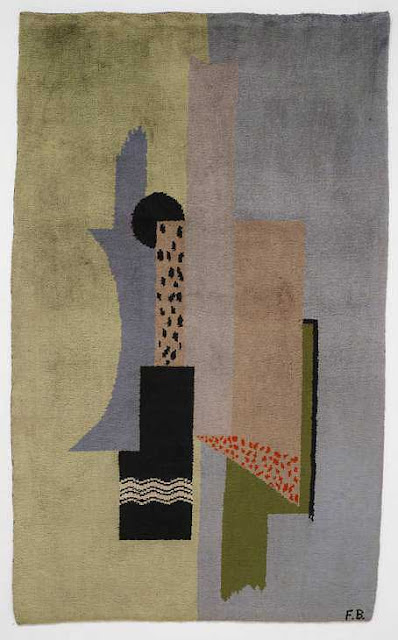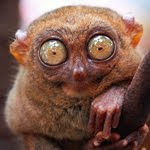Rare rugs and paintings which Francis Bacon completed when he was working as an interior designer are to go on display for the first time.
Hidden in private collections for decades, they escaped the artist's attempts to destroy his early artworks which he believed were inferior to his later masterpieces.
Experts claim the pieces give a vital insight into how his interior design work influenced his more famous works.
To mark the centenary of Bacon's birth on October 28, Francis Bacon: Early Work at Tate Britain will include three rugs and a painted screen dating from 1929 when the then 20-year-old Bacon was decorating homes in London.
[...] From 1928 to 1930, Bacon worked in London, Paris and Berlin, designing entire interior schemes together with individual pieces of furniture. He began to incorporate some of his interiors work into his first paintings, such as Watercolour (1929), his earliest surviving painting which appears to have evolved from his carpet designs.
Aged 19, his studio in South Kensington was featured in an interiors magazine in a piece entitled "The 1930 Look in British Decoration".
His clients included the Australian painter Roy de Maistre, who later became his mentor, and Sydney Butler, the daughter of the art collector Samuel Courthauld, for whom he designed a dining table and set of stools for her London home.
Matthew Gale, the curator of Modern Art and Head of Displays at Tate Modern, [..] said: "Seeing where an artist comes from is always an incredibly intriguing and revealing thing. Not many people know that Bacon started out in interior design because he didn't make a big thing about it in later life. [...] These works show him linked to a European modernist tradition, with a debt to Picasso and building on cubism as he made the shift from decorator to painter" (Roya Nikkhah, From Decorator to Painter: Francis Bacon's Interior Designs go on Show, Telegraph, 27.9.2009).
 |
| Ivan da Silva Bruhns Carpet, 280 x 135 cm. Claude Boisgirard, Paris |
 |
| Rug, c. 1929. Wool, 213 x 125 x 1 cm. Private collection |
Late 1920s Paris was a pivotal center of artistic endeavour and decorative activity following the great Exposition des Arts Décoratifs in 1925, from which emeged the Art Deco fashion. Many artisans were commissioned to create furnishings and rugs for the grand stores, and it would have been hard not to be affected by the explosion of such new enthusiasm. Bacon saw Picasso's work in Paris. He may have also seen the work of Fernard Léger. Bacon himself recognised that during his early years as a designer he had been influenced by a number of modernists. He was reluctant in mentioning names, yet there are important stylistic correspondences with the output of artists and designers such as Ivan da Silva Bruhns, Gustave Miklos, Eileen Gray, and Fernand Léger. Perhaps even Jean Lurçat should be reconsidered.
 |
| Francis Bacon, Rug, c. 1929, compared with carpets by Gustave Miklos (Collage Rug, 1925), Eileen Grey (Runner, 1927) and Fernand Léger (Rouge, 1927). Plate by Mariano Akerman, 1.11.2008 |
Gustave Miklos. French artist of Hungarian origin, 1888-1967. Developed small sculptures and objets d’art in Art Deco style.
Eileen Gray. Irish lacquer artist and furniture designer, 1878-1976. Developed work in stark International Style in London from 1925 onwards.
Francis Bacon. British artist, 1909-1992. Active in decoration in London around 1928-30
Fernand Léger. French painter, 1888-1955: "Cherchant l'éclat et l'intensité, je me suis servi de la machine, comme il arrive à d'autres d'employer le corps nu ou la nature morte. On ne doit jamais être dominé par le sujet... L'objet fabriqué est là, absolu polychrome net et précis, beau en soi... Je ne me suis jamais amusé à copier une machine. J'invente des images de machines, comme d'autres font d'imagination, des paysages. L'élément mécanique n'est pas pour moi un parti pris, une attitude, mais un moyen d'arriver à donner une sensation de force et de puissance" (Musée Fernand Léger, Biot). "Allez-voir le Salon de l'automobile, de l'Aviation, la Foire de Paris qui sont les plus beaux spectacles du monde" conseillait Fernand Léger. Comme dans la vie moderne, l’objet prend une place dominante dans l’œuvre de l’artiste. Ce ne sont pas les fonctions des objets, mais leurs formes, qui l’intéresse. Il ne retient que leur valeur esthétique. D'improbables mécaniques envahissent la toile avec tous les moyens plastiques possibles, contraste, groupement, multiplication. [...] Les éléments de la composition sont à la fois empruntés à des objets manufacturés et à des éléments décoratifs" (ibid).
 |
| Bacon, Composition, c. 1929 Wool carpet, 200 x 120 cm. Artcurial Briest-Poulain-F. Tajan, Paris |
A research on Bacon's carpets ant their sources of inspiration has been developed by Clive Rogers and Jean Manuel de Noronha in Europe in 2009. Working together, they aimed to link Bacon's rugs imagery to that of other European creators. As one observes and compares the composition and motifs present in the third and fourth images illustrated in this post, undeniable affinities emerge.
 |
| Bacon, Rug, undated Contemporary Rugs, ed. Chistopher Farr, 2002, p. 21 |
Bacon was creative yet not alwas able o even willing to indicate his sources of inspiration accurately. Of some of them he was of course much aware. Other sources seemingly escaped his memory or he perhaps he was not completely aware of them. Much he kept only for himself, as if it had never existed. But Bacon's work has visual referents. Rogers and Noronha are interested in Bacon's early imagery and suggest possible influences on Bacon's work (Rogers and Noronha, "Rugs of the Young Francis Bacon", Hali Magazine #162, Winter 2009).
Between 1928 and 1930, Bacon devoted a brief affair with some prevalently abstract and decorative designs. Decades later he was to become well known and recognized because of his (dis)figurative paintings. In the seventies he emphatically despised both abstraction and decoration. Nevertheless, Bacon's work never got completely rid of such aspects. No matter how much grotesque physicality he imbued his paintings with, aesthetic concerns have always been at the core of his art.
The issues of abstraction and decoration in Bacon's art were first introduced by Rothenstein and Alley (London, Tate Gallery, Francis Bacon, catalogue raisonné, 1962-64). In 1975, Bacon despised them both ("Remarks", ed. by Peter Beard, in: New York, Metropolitan Museum of Art: Bacon; and those in Interviews with Francis Bacon, ed. David Sylvester).
While researching Bacon's imagery in the Malrborough Fine Art Gallery of London in 1995, I had a conversation with Miss Valery Beston, who then reminded me of the great importance that Bacon always attributed to the way his work looked. Indeed, appearance was far from being a mere accessory in Bacon's life and work. She felt that design was a constant in Bacon's case, no mattering how chaotic anything he did might seem to be so. We were considering Bacon's working method and art production, not his private life. Besides, Miss Beston did not hesitate in stressing that none of the then recently published "Bacon biographies" had had the painter's authorization, so they all needed to be approached very cautiously.
In the lectures on Bacon that I gave in Argentina and Asia since 1992 onwards, the aspects of decoration, abstraction and design were always considered. And so was Bacon's debt to modern creators, such as De Chirico, Léger, and Picasso.
In my 1999 research, The Grotesque in Francis Bacon's Paintings, each of the above-mentioned aspects is considered, explaining that both decoration and abstraction had been qualified as "meaningless" by Bacon precisely because they did not allow him to convey his fundamental message, which was grotesque, and thus persistently yet not accidentally double-edged.
Aware of the Art Deco and modernist flavour of Bacon's rugs imagery, I have tried to compare it to that of some other modernist rug creators. My comparisons are a way of considering additional possibilities. Being that so, and as a counterpoint of Bacon's insistent claims that his work had nothing to do with decoration nor with abstraction, relating Bacon's 1929-30 work to that produced in France by the mid-1920s seems appropriate and telling. —Mariano Akerman
References and resources. For rugs in Art Deco and Modernist styles, see The Arts and Crafts Home, Brighton. On Rogers-Noronha collaboration, see The Carpet Index; and Orient Rug.










2 comments:
Oh, it is a great post! I really like it! ^_^
Bacon was influenced by Léger, Picasso, Lurçat, and Gray. Besides, when Bacon created the 1929 rugs he had in mind two other designers called Marion Dorn and McKnight Kauffer.
Post a Comment